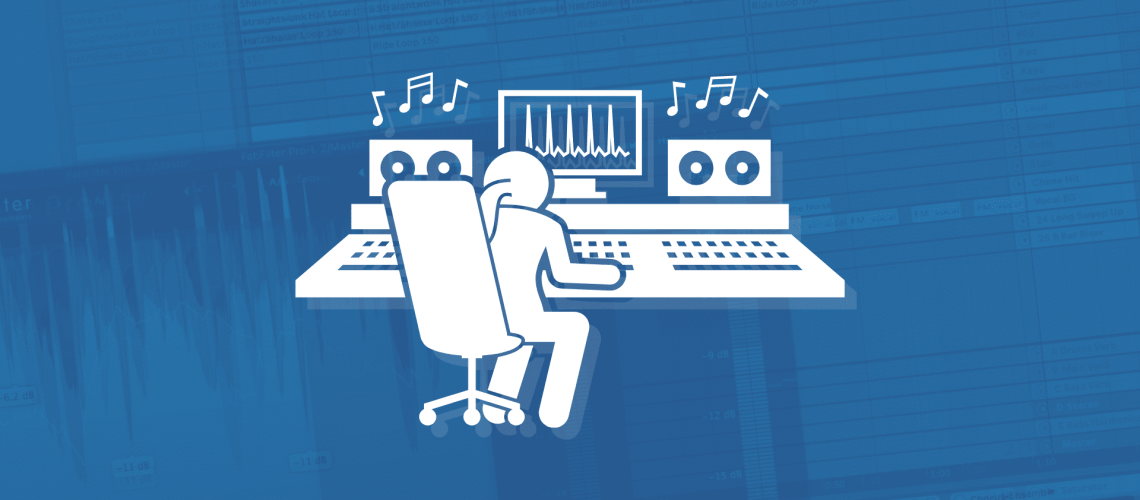Want to learn how to make dubstep? Especially that UK/140 vibe that is so popular right now?
Then you’ve come to the right place!
In this guide, we’ll cover the entire production process of a deep, UK Dubstep track. Along the way, there will be plenty of creative options to take things in your own direction.
If you want to follow along, make sure to download the full project file and sample pack for free right here 👇
Step 1: BPM and Structure
So the first thing we are going to do is set the BPM to 140. This is the typical BPM used for this style of UK Dubstep. Next, let’s create a new MIDI track which we are going to call “Structure”.
Here, we’ll just use some dummy blank MIDI clips to map out the structure of our track.

Let’s go by eight bar increments as this is quite standard in UK Dubstep:
- intro (first 8 bars);
- build (8bars);
- drop 1A (8 bars);
- drop 1B (8 bars);
- drop 1C (8 bars);
This will be enough to get us started. This structure is roughly built off of my experience with different reference tracks in this style.
Once we’ve set that up, we can start building our Dubstep drums 😈.
Want to check out this tutorial in video format? Head over to our YouTube channel 👇
Step 2: How to Make Dubstep Drums
We’re going to use some samples from our own EDM Starter Kit for the main drums.
First let’s create a new audio track in Ableton Live, and call it “Kick”. Chuck in “Kick 28”, which has a nice deep dubstep-y feel to it. I just find it’s a bit too long in terms of the tail so I’m going to fade that out a bit:

We’ve got to think about the fact that in Dubstep, there’s a lot of sub-bass. So our kicks shouldn’t be too boomy.
Next, we’re just going to program a classic two-step pattern:
Now we can start to bring in some clap samples. In deep Dubstep, producers tend to use claps and rim shot samples rather than huge, chunky snares like you might hear in Riddim or Brostep.
Let’s grab “Clap 7” from the EDM Starter Kit. We might layer a few samples together here to get a bit more of a thicker sound.

What we might do is add a bit more reverb to this clap. Let’s do this through a Send channel.
Next up, let’s add some EQ8 and take out some of the lows. We’re also going to add this sort of snare sound from a Splice pack. It’s actually from a Trap pack but it has this nice noisy top end which I want to layer up with our main clap.
Let’s blend these two layers together with some EQ to remove unnecessary lows and resonances, and a bit of reverb:
To make our lives easier, I’m actually going to resample this into our own clap. To do this:
- turn off the reverb;
- add a new audio track;
- set the input type to “Resampling”;
- arm the recording on the resampling channel;
- press record.
Boom! We now have our very own clap! We can now add back some of that reverb from the Send channel, and delete the 2 original layers.
Hats, shakers, and percussion
We’ve got the foundation of our beat, but it’s still sounding pretty empty. So let’s get some nice hats and shakers.
UK Dubstep tends to have quite rhythmic, “shuffle-y” drums rather than heavy-hitting drums. So let’s bring in a shaker loop.
I found this shaker loop on Splice which I really like
What I want to do next is add some shuffle to it. To do this, we are going to use Ableton’s Groove Pools.
I settled on the “2 Step Suffled 16th” groove:

This is going to give a completely new feel to our shakers:
We also want to add a more subtle, background ride cymbal here:

And of course, some hi-hats to really lock in our beat:
Nice 😍
Step 3: How to Make a Dubstep Bass (Sub and Mid)
Let’s move on to the bass now.
Let’s kick things off with the sub-bass, and for this, I’m going to use Serum.
So let’s create a new MIDI track and call it Main Sub. What I like to do at this stage is grab a basic sound in Serum and start to program in the bass, even though the sound isn’t fully there yet.
Here’s the sound we can start off with:
By the way, we’ll go for E minor for this song. That will give it a nice, deep feeling.
Here are a few things we can do next to make this sound more “dubsteppy”:
- apply an MG Low 24 Filter;
- apply LFO 1 (on “Dome” preset) to the cutoff of Filter A;
- set LFO 1 rate to 1/8 dotted.
This is what it should sound like now:
Next, let’s write a melody:
Let’s do some slight variation for the next 8 bars:

Now that we have our melody, we can start dialing in a better sound in Serum.
Let’s try some FM modulation:
- turn on oscillator B and set the level to 0;
- set the Oct to +2;
- in the Warp menu of OSC A, select FM (FROM B);
- turn the Random to 0 on both oscillators to avoid artifacts;
We’re also going to add some effects inside of Serum, including Hyper Dimension, Distortion, and a Comb Filter:

Finally, in Ableton Live I’m going to add some more saturation, multiband compression as well as sidechain compression (so that the bass ducks on each kick drum).
Here’s what we’ve got now:
Finally, one last step is to EQ our bass so that:
- it doesn’t clash with our kick and clap
- it comes through on smaller speakers
To achieve this, we are going to EQ around 100 to 300 Hz with some narrow cuts. Then, in the 1k to 3k Hz range, this is where we hear the sound the most. So if your bass is not cutting through enough, try boosting this region.

Bass modulation
A key thing in UK Dubstep is to modulate your bass as the track moves forward. Because UK Dubstep tracks are usually quite minimal, modulating your bass is a great way to keep things interesting.
To modulate parameters inside of Serum, a great technique is to use Macros.
Macros are the knobs on the left, under the “Mod” tab. Basically, you can assign any number of parameters to a single Macro knob. Then, by turning that knob up or down, you will affect all the parameters linked to it.
For example, you could link the Detune of OSC A and the Cutoff frequency of Filter A to Macro 1:

Now, I can control the amount of Macro 1 with automation, and this will modulate both the Detune and Cutoff at once!
For our bass, here are a few macros I’m going to create:
- assign the cutoff of Filter A to Macro 1;
- assign FM FROM B to Macro 2;
- assign the Drive amount of our distortion to Macro 3;
- assign the Mix amount of our distortion to Macro 3.
The reason for assigning the mix amount is that when we increase the drive, the volume also goes up. So we want to apply a “reverse” modulation to the mix amount: when the drive goes up, the mix goes down. That way, we keep the volume roughly constant.
Once that’s done, we can start creating automations in our track! 😊

Mid basses and fills
Now, let’s have a bit of fun with some bass fills 😈
One really cool technique I like to do for mid-basses is to duplicate out the whole sub-bass, freeze it, and flatten it.
Then we can go nuts with post-processing and see what we get.

We’re not going to use all this audio, but we are just going to use it as a source for making sick, distorted effects. Here you can grab your favorite distortion plugin (I’m going to use Rift). Here are some cool sounds I came up with:
Next, we want to fade in just some sections. We don’t need this mid-bass to be playing non-stop:

You can do this trick on any section of your track, but it works especially well on end of phrases.
Step 4: Adding an Intro Hook and Atmosphere
For the intro, what I want to do is create a completely separate, non-bass hook.
I don’t want to do something generic like an atmosphere, but something a bit more rhythmic and choppy.
So let’s create a new MIDI track called “Hook”, find a sample we like a start chopping it up and processing it. To be honest, here, there are no hard and fast rules. It’s all about trying different kinds of processing, and seeing what you like and what fits the track.
Here are some of the effects I used for my intro hook:
And of course, your standard EQ, and compression 🙂
Here’s what I got in the end with some hats and claps thrown in:
You can also try using a vocal sample and chop it up.
Next up, let’s add some background sound. Usually some nice atmosphere, like a cassette noise, can really do the trick. This will give our track that old-school gritty feeling.
Let’s also add some spooky atmospheres:
Finally, let’s add an upsweep and a sub-drop to lead into our build-up:

Step 5: Creating a Buildup
All right! Now that we’ve done our intro, let’s actually turn our attention to the build.
The first thing we are going to do here is duplicate our kick track. We are going to use it to build up the energy.
To do this, I’m simply going to put a kick on each beat, remove the highs with an EQ, and slowly bring the volume up:

You can also double the number of kicks to create more tension after 4 bars, then double it again after 2 bars. We are also going to add some of the crashes, hats, and effects used in the intro.
We also need some kind of pre-drop vocal:
All we need to do now is process it with EQ, reverb etc.
Interested in checking the rest of this tutorial, including a full mixdown and mastering? Head over to our YouTube channel 👇
That’s How To Make Dubstep! – REMOVE REDIRECT
Phew – if you made it through all of that, great job. You’ve just made a whole dubstep track!
At this stage, you’re welcome to make whichever tweaks you like to make the song your own. Or better yet, use this overall framework to create your own from scratch!
If you want to take your learning further as a producer, make sure to sign up for our Free Masterclass which will help you:
- focus on the right things as a producer
- accelerate your musical journey (so it takes months, not years to get good)
- give you all the resources you need
Did I miss something in this guide? Flick me an email at [email protected]




